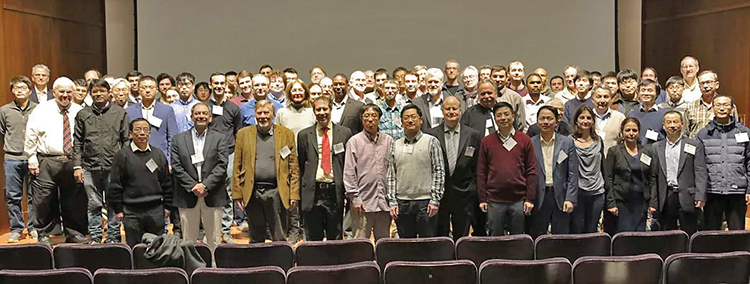Ferroelectric Theory Meets Experiment in Washington, DC
Ferroelectric Theory Meets Experiment in Washington, DC
Fundamental Physics of Ferroelectrics and Related Materials
Held at the beautiful Carnegie Institution for Science in the heart of Washington, DC, the 2018 Fundamental Physics of Ferroelectrics and Related Materials, or Ferro2018, was a gathering of the world’s leading researchers in ferroelectric materials. Between the banquet dinners and croissant-laden coffee breaks, I experienced a sharing and developing of knowledge in which few, if any, undergraduate students usually get the chance to participate. My goal was to learn as much as possible.
The study of ferroelectrics involves materials that exhibit ferroelectric behavior—that is, they have a macroscopic nonzero polarization that can be reversed, or switched, with the application of an external electric field. It is a behavior that stems from off-center symmetries in materials, and the science involved is fundamentally interdisciplinary.
Related topics include multiferroics (which are materials that couple both ferroelectricity and ferromagnetism), relaxors (which display nanodomains of polarization even after the critical temperature is reached), antiferroelectrics (in which neighboring lines of ions are polarized in antiparallel directions), and more. Ferro2018 had experts in all these fields from around the world presenting their ongoing work and their findings.
The four-day workshop was divided into 12 sessions, each covering a specific topic, and one poster session. Following a short reception Sunday evening, the workshops started full-swing Monday morning with the first session of talks, this one titled “Domains and Domain Walls”. I was particularly fascinated by Dr. Julia A. Mundy of Harvard University’s talk, “Functional Electronic Inversion Layers at Ferroelectric Domain Walls.”
The work Mundy and her group have done is pushing the boundaries of ferroelectrics as a field. In this part of their research, they sought to answer a central question: How can we explain electronic transport jumps in ferroelectric ErMnO3? The results produced in pursuit of answers could lead to insight into charged domain walls, which in turn holds great promise as the first truly two-dimensional functional materials.
Over dinner Monday, I sat down with Dr. Raffaele Resta of the University of Trieste in Italy. Resta has been involved with the conference since its inception in 1989 and had much to say about the workshop’s history. At one point I asked Dr. Resta, “I heard earlier that the modern theory of polarization was developed at this conference in its early days. What do you know about that?”
He replied with a smile on his face. “That was me,” he began, much to my surprise (and awe).
He recounted how in one of the first years of the workshop, after a fellow attendee, David Vanderbilt, had heard his talk, they met to discuss some new ideas. Over the next few months, they developed one of the most fundamental theories of modern ferroelectric study, the theory of polarization.
Attending the talks, listening to conversations during breaks, and at the poster session, I witnessed glimpses of similar activity all around me. Attendees approached each other after talks, mentioning specifics of their presentations and setting up meetings over lunch or dinner to discuss new ideas and solutions to problems. In that way, Ferro2018 was rightly called a “workshop” and not a “conference”; it was abuzz with intellectual activity.
Around noon on Wednesday, after the last talks were over and most of the attendees had left, I stuck around to help clean up and catch any last bits of wisdom. Dr. Peter Gehring, a researcher at NIST, and I struck up a conversation. As one of the conference organizers, Dr. Gehring had also seen the conference—as well as the field of ferroelectrics itself—develop over time, and he had a lot to say about it.
With every new advancement in ferroelectrics, he said, researchers become more and more specialized, narrowing their spheres of knowledge. “When you only know how to use a hammer, every problem begins to look like a nail,” he said. The best researchers are the ones who can not only perform effective research, but also contextualize that work in the larger field of ferroelectrics and physics in general. He said a growing challenge in the future will be to convince scientists to care about the field beyond their own work.
But Dr. Gehring was optimistic. “[The workshop] might seem sleepy at times, but these people here are some of the best around,” he said.
I couldn’t help but think what Ferro2019 will look like. From the outside, it will most likely be similar—the talks and posters will continue to be filled with equations and diagrams, and the coffee breaks will still have croissants. But with new attendees working side-by-side with familiar faces such as Dr. Resta and Dr. Cohen, the research shared and knowledge produced will be quite different. I’m looking forward to finding out.
Special thanks to Dr. Ronald Cohen of the Carnegie Institution for Science for his work in organizing Ferro2018 and allowing me the opportunity to attend it, as well as to the SPS for its continued support of physics education and the students who pursue it.

